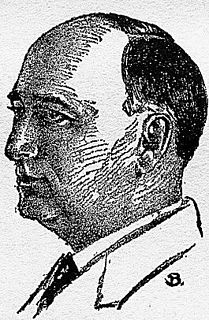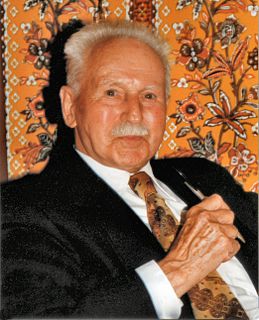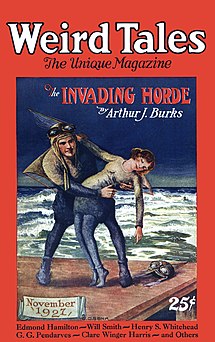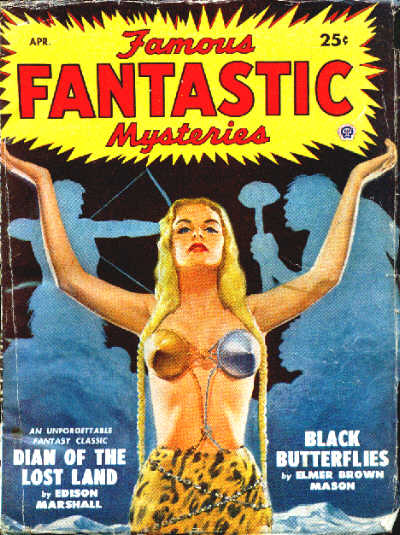
Pulp magazines were inexpensive fiction magazines that were published from 1896 to the 1950s. The term pulp derives from the cheap wood pulp paper on which the magazines were printed. In contrast, magazines printed on higher-quality paper were called "glossies" or "slicks". The typical pulp magazine had 128 pages; it was 7 inches (18 cm) wide by 10 inches (25 cm) high, and 0.5 inches (1.3 cm) thick, with ragged, untrimmed edges.
Argosy, later titled The Argosy and Argosy All-Story Weekly, was an American pulp magazine from 1882 through 1978, published by Frank Munsey. It is the first American pulp magazine. The magazine began as a children's weekly story–paper entitled The Golden Argosy. In the era before the Second World War, Argosy was regarded as one of the "Big Four" pulp magazines, - the most prestigious publications in the pulp market, that many pulp magazine writers aspired to publish in. John Clute, discussing the American pulp magazines in the first two decades of the twentieth century, has described The Argosy and its companion All-Story as "the most important pulps of their era."

Carl Richard Jacobi was an American journalist and author. He wrote short stories in the horror and fantasy genres for the pulp magazine market, appearing in such pulps of the bizarre and uncanny as Thrilling, Ghost Stories, Startling Stories, Thrilling Wonder Stories and Strange Stories. He also wrote stories crime and adventure which appeared in such pulps as Thrilling Adventures, Complete Stories, Top-Notch, Short Stories, The Skipper, Doc Savage and Dime Adventures Magazine. He also produced some science fiction, mainly space opera, published in such magazines as Planet Stories. He was one of the last surviving pulp-fictioneers to have contributed to the legendary American horror magazine Weird Tales during its "glory days". His stories have been translated into French, Swedish, Danish and Dutch.
Frederick Orlin Tremaine was an American science fiction magazine editor, most notably of the influential Astounding Stories. He edited a number of other magazines, headed several publishing companies, and sporadically wrote fiction.

A science fiction magazine is a publication that offers primarily science fiction, either in a hard copy periodical format or on the Internet.
The first Golden Age of Science Fiction, often recognized in the United States as the period from 1938 to 1946, was an era during which the science fiction genre gained wide public attention and many classic science fiction stories were published. In the history of science fiction, the Golden Age follows the "pulp era" of the 1920s and 1930s, and precedes New Wave science fiction of the 1960s and 1970s. The 1950s are a transitional period in this scheme; however, Robert Silverberg, who came of age in the 1950s, saw that decade as the true Golden Age.
Popular Publications was one of the largest publishers of pulp magazines during its existence, at one point publishing 42 different titles per month. Company titles included detective, adventure, romance, and Western fiction. They were also known for the several 'weird menace' titles. They also published several pulp hero or character pulps.

David Henry Keller was an American writer who worked for pulp magazines in the mid-twentieth century, in the science fiction, fantasy and horror genres. He was the first psychiatrist to write for the genre, and was most often published as David H. Keller, MD, but also known by the pseudonyms Monk Smith, Matthew Smith, Amy Worth, Henry Cecil, Cecilia Henry, and Jacobus Hubelaire.

Miles John Breuer was an American physician and science fiction writer. He was part of the first generation of writers to appear regularly in the pulp science fiction magazines, publishing his first story, "The Man with the Strange Head", in the January 1927 issue of Amazing Stories. His best known works are "The Gostak and the Doshes" (1930) and two stories written jointly with Jack Williamson, "The Girl from Mars" (1929) and The Birth of a New Republic (1931).
Blaster Al Ackerman was an American mail artist and writer. Ackerman had been active various subcultures since the early 1970s.

Edgar Hoffmann Price was an American writer of popular fiction for the pulp magazine marketplace. He collaborated with H. P. Lovecraft on "Through the Gates of the Silver Key".

Arthur J. Burks was an American writer and a Marine colonel.

Henry James O'Brien Bedford-Jones was a Canadian historical, adventure fantasy, science fiction, crime and Western writer who became a naturalized United States citizen in 1908.

Typewriter in the Sky is a science fantasy novel by American writer L. Ron Hubbard. The protagonist Mike de Wolf finds himself inside the story of his friend Horace Hackett's book. He must survive conflict on the high seas in the Caribbean during the 17th century, before eventually returning to his native New York City. Each time a significant event occurs to the protagonist in the story he hears the sounds of a typewriter in the sky. At the story's conclusion, de Wolf wonders if he is still a character in someone else's story. The work was first published in a two-part serial format in 1940 in Unknown Fantasy Fiction. It was twice published as a combined book with Hubbard's work Fear. In 1995 Bridge Publications re-released the work along with an audio edition.

Harl Vincent was the publication name of Harold Vincent Schoepflin, an American mechanical engineer and science fiction author. He was published regularly in science fiction "pulp" magazines.

Joseph Allan Elphinstone Dunn, best known as J. Allan Dunn, was one of the high-producing writers of the American pulp magazines. He published well over a thousand stories, novels, and serials from 1914–41. He first made a name for himself in Adventure. At the request of Adventure editor Arthur Sullivant Hoffman, Dunn wrote Barehanded Castaways, a novel about people trapped on a desert island which was intended to avoid the usual cliches of such stories. Barehanded Castaways was serialised in 1921 and was well received by Adventure's readers. Well over half of his output appeared in Street & Smith pulps, including People's, Complete Story Magazine, and Wild West Weekly. Dunn wrote over a thousand stories. He wrote approximately 470 stories for Wild West Weekly alone. His main genres were adventure and western; although he did write a number of detective stories, most of them appearing in Detective Fiction Weekly and Dime Detective. Dunn wrote The Treasure of Atlantis, a science fiction story about survivals from Atlantis living in the Brazilian jungle. The Treasure of Atlantis was published in All-Around Magazine in 1916 and later reprinted in 1970. He was a specialist in South Sea stories, and pirate stories. He also published a lot of juvenile fiction; including many stories for Boys' Life, primarily in the 1920s. A number of his novel-length stories were reprinted in hardbound, some under the pen name "Joseph Montague" for Street & Smith's Chelsea House imprint; many of his books were issued in the United Kingdom. His stories were frequently syndicated in newspapers, both in America and around the world, making him, for a time, a very widely known author.
American Fantastic Tales is a set of two reprint horror anthologies, released as American Fantastic Tales: Terror and the Uncanny from Poe to the Pulps and American Fantastic Tales: Terror and the Uncanny from the 1940s to Now. Both anthologies were edited by Peter Straub. They were published by Library of America in 2009. The anthologies contain horror stories by American authors from the 18th century to modern times, split at 1940. The anthology pair itself won the 2010 World Fantasy Award for Best Anthology. The pair were also released as a boxed set in 2009.

Science fiction and fantasy magazines began to be published in the United States in the 1920s. Stories with science fiction themes had been appearing for decades in pulp magazines such as Argosy, but there were no magazines that specialized in a single genre until 1915, when Street & Smith, one of the major pulp publishers, brought out Detective Story Magazine. The first magazine to focus solely on fantasy and horror was Weird Tales, which was launched in 1923, and established itself as the leading weird fiction magazine over the next two decades; writers such as H.P. Lovecraft, Clark Ashton Smith and Robert E. Howard became regular contributors. In 1926 Weird Tales was joined by Amazing Stories, published by Hugo Gernsback; Amazing printed only science fiction, and no fantasy. Gernsback included a letter column in Amazing Stories, and this led to the creation of organized science fiction fandom, as fans contacted each other using the addresses published with the letters. Gernsback wanted the fiction he printed to be scientifically accurate, and educational, as well as entertaining, but found it difficult to obtain stories that met his goals; he printed "The Moon Pool" by Abraham Merritt in 1927, despite it being completely unscientific. Gernsback lost control of Amazing Stories in 1929, but quickly started several new magazines. Wonder Stories, one of Gernsback's titles, was edited by David Lasser, who worked to improve the quality of the fiction he received. Another early competitor was Astounding Stories of Super-Science, which appeared in 1930, edited by Harry Bates, but Bates printed only the most basic adventure stories with minimal scientific content, and little of the material from his era is now remembered.

Futuria Fantasia was an American science fiction fanzine created by Ray Bradbury in 1938, when he was 18 years old. Though only 4 issues of the fanzine were published, its list of contributors included Hannes Bok, Forrest J. Ackerman, Henry Kuttner, Damon Knight, and Robert A. Heinlein.

















